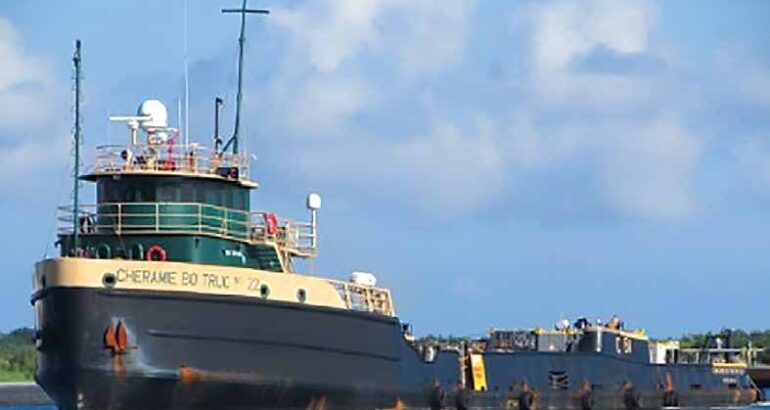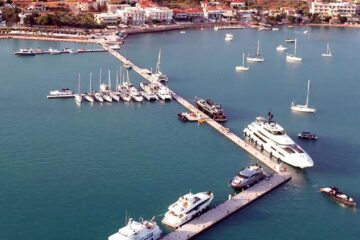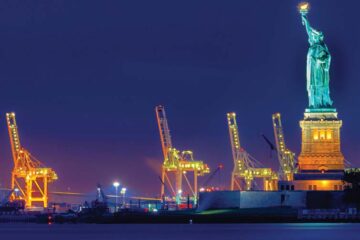NTSB Accident Brief
On November 14, 2019, about 0415 local time, the offshore supply vessel Cheramie Bo Truc No 22 was outbound for sea, transiting Sabine Pass with a crew of five, when it collided with the inbound articulated tug and barge (ATB) Mariya Moran/Texas, with a pilot and nine crew aboard, in the vicinity of Texas Point. About 6,641 gallons of diesel oil were released, and the waterway was closed for 12 hours. No injuries were reported. The Cheramie Bo Truc No 22, valued at $1.2 million, was declared a total loss. The Mariya Moran and Texas sustained $654,572 in damages.
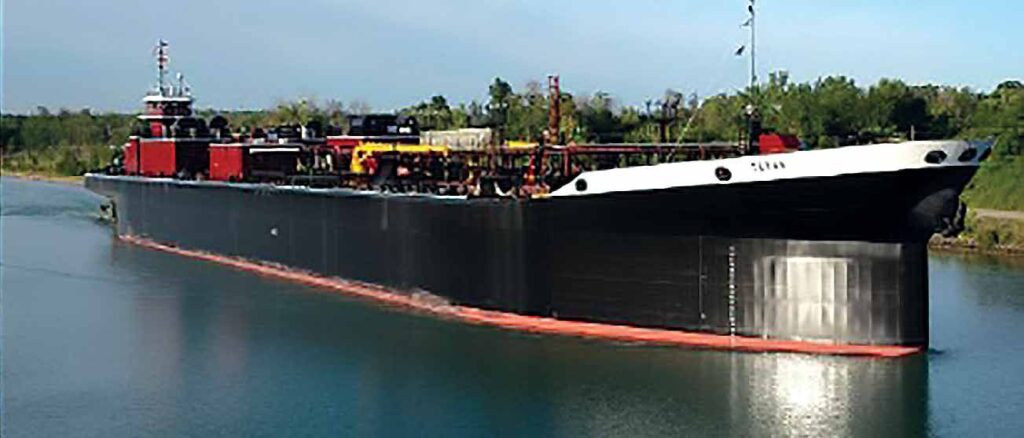
Background
The Cheramie Bo Truc No 22 was built at Bollinger Shipyards, Inc. in New Orleans in 1975. The 167-footlong, 2,000-horsepower offshore supply vessel was crewed with a master, mate, unlicensed engineer, and two able seamen (ABs). The Cheramie Bo Truc No 22 was chartered to Genesis Energy to supply offshore oil and gas platforms.
The 116-foot-long, 6,000-horsepower towingvessel Mariya Moran was built in 2015 at Patti Shipyards in Pensacola, Florida. The 425-foot-long, 161,815-barrel-capacity product barge Texas was built in 2015 by Bay Shipbuilding Co. of Sturgeon Bay, Wisconsin. The vessels were joined together as a 580-foot-long, 78-foot-wide ATB, a unit consisting of a barge with a notch in the stern for an accompanying tug to make fast with mechanical pins.
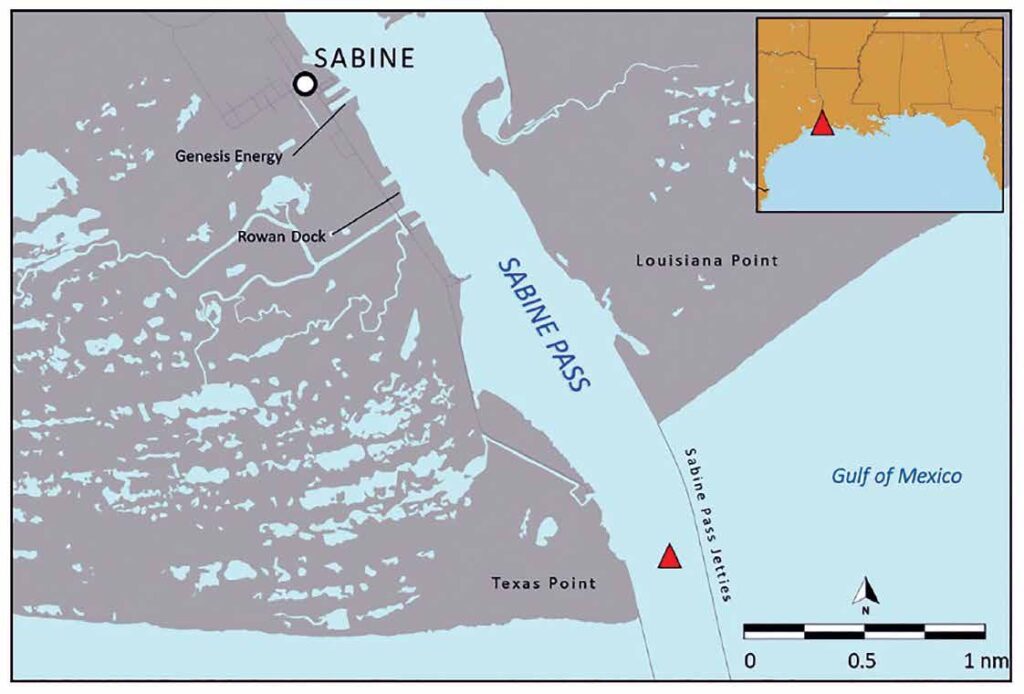
Accident Events
On November 14, 2019, the Cheramie Bo Truc No 22 left the Genesis Energy dock at 0352, en route to West Cameron Block 167, and checked in with the Coast Guard’s Vessel Traffic Service (VTS) Port Arthur. (Genesis Energy’s platform at West Cameron Block 167, approximately 25 miles southeast of the Sabine Pass jetties, is a node in the High Island Offshore System gas pipeline.) The mate was alone on the bridge until the on-watch AB and the engineer joined him after unmooring the vessel. Immediately upon entering the channel, the mate attempted to use the autopilot feature for several minutes but was unsuccessful, according to the AB and engineer. In describing the resulting erratic wake, the AB said, “I’m looking back there and it looks like a snake.” The AB stated that twice he and the engineer had to remind the mate to steer back into the channel. The mate ceased using the autopilot, returning to manual steering, as the vessel approached two stationary jack-up mobile offshore drilling units (MODUs) positioned near the Rowan Dock on the west bank. (A jack-up is a bottom-bearing MODU.)
After narrowly avoiding the jack-ups, automatic identification system (AIS) and VTS data showed the Cheramie Bo Truc No 22 crossed the channel at 0400 at a near right angle, then followed the east side of the channel. The Cheramie Bo Truc No 22 started back across the channel to the west side at 0407 and passed a pilot boat, port to port, at 0410 near buoy 29. The vessel continued down the west side of the channel until the mate passed near buoy 27 at 0412. At this bend in the channel, the Cheramie Bo Truc No 22 again crossed the channel to the east side, about 1 mile ahead of the inbound Mariya Moran/Texas. As the vessels approached each other, the Cheramie Bo Truc No 22 AB reported sighting the Mariya Moran/Texas, which the mate acknowledged, stating, “That’s a ship.”
En route from Port Everglades, Florida, the Mariya Moran/Texas ATB weighed anchor outside the jetties about 0330, checked in with VTS, and proceeded inbound to load at Valero Dock no.1 in Port Arthur. About 0400, roughly 0.5 miles inside the jetties, a Sabine pilot boarded the Mariya Moran/Texas, and the AB escorted him to the wheelhouse. According to the pilot, it took about 10 minutes to reach the wheelhouse and set up his equipment. The chief mate and pilot completed a master/pilot exchange, and the pilot checked in with VTS, who advised him of the outbound Cheramie Bo Truc No 22, which the pilot acknowledged. The pilot stated he saw the Cheramie Bo Truc No 22 on his portable pilot unit before relieving the chief mate at the helm (the Mariya Moran had no dedicated helmsman). The Mariya Moran/Texas was in the center of the channel, making 8 knots over ground against an ebb tide, according to the chief mate.
After the master/pilot exchange, the chief mate stepped outside on the port bridge wing to smoke. The pilot first noticed the Cheramie Bo Truc No 22’s masthead lights about 1 mile away. He stated the offshore supply vessel was maintaining the red or east side of the channel. He told investigators this was common for vessels that may be headed east once clear of the jetties, as would be the case for the Cheramie Bo Truc No 22, and it was not unusual to meet starboard to starboard in the channel.
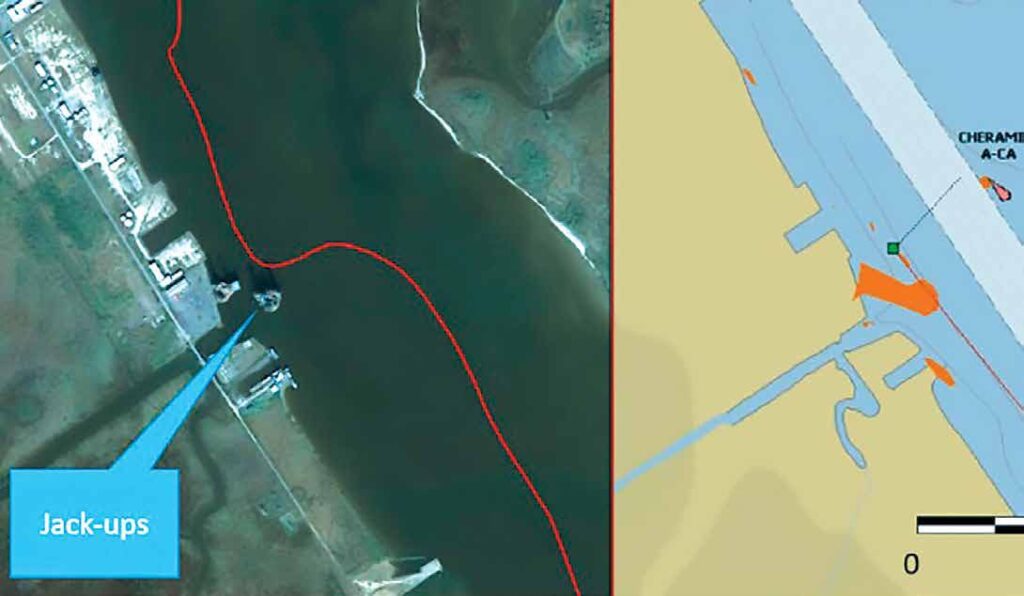
About 0414, Cheramie Bo Truc No 22 started a turn to starboard. The AB and engineer noticed the mate start the turn and recommended he come left to avoid the ATB. The mate did not acknowledge them. The Mariya Moran/Texas pilot hailed the Cheramie Bo Truc No 22 on channel 13, to which the mate answered. During the radio call, believing a collision was imminent on the Cheramie Bo Truc No 22, the AB left the bridge, and the engineer ran from the port side of the bridge to starboard and braced himself.
On the Mariya Moran/Texas, the chief mate outside the wheelhouse did not hear the pilot talk to the Cheramie Bo Truc No 22 but noticed a “black thing” fine on the port bow about the same time the pilot knocked on the window to get his attention. The chief mate stepped inside, glanced at the electronic chart system, thought that they were on the west edge of the channel, and became concerned they were headed aground. He asked the pilot to come right just as he felt the vessel shudder and assumed they had grounded.
The VTS supervisor told investigators that the VTS watchstander, monitoring VHF channels 13 and 1A, did not hear any passing arrangements made by radio. The VTS watchstander noticed the Cheramie Bo Truc No 22’s “course had changed abruptly,” placing the vessels on a collision course. He reached out to the Cheramie Bo Truc No 22 once, on channel 1A (which vessels were required to monitor while transiting the area), with no answer.
The bow (stem) of the barge Texas collided with the Cheramie Bo Truc No 22 at nearly a right angle, aft of the superstructure. The Cheramie Bo Truc No 22 mate was thrown from his chair. The Mariya Moran’s assistant engineer felt the engines go full reverse after the collision. The Cheramie Bo Truc No 22 drifted past the Mariya Moran/Texas’s starboard side, and the Mariya Moran chief mate ordered the AB and the tankerman to the bow to standby at the anchor.
The pilot aboard the ATB informed VTS of the collision on channel 1A. VTS then notified search and rescue assets and pollution responders, closed the waterway to traffic, and directed the Mariya Moran/Texas ATB and two other inbound vessels to anchorage. The Mariya Moran captain relieved the pilot at the helm and proceeded to the inside anchorage. The Cheramie Bo Truc No 22 anchored in the pass until about 1100 the following day while pollution responders were on scene. One-way traffic was allowed in the waterway later that afternoon, and the waterway opened fully the next day.
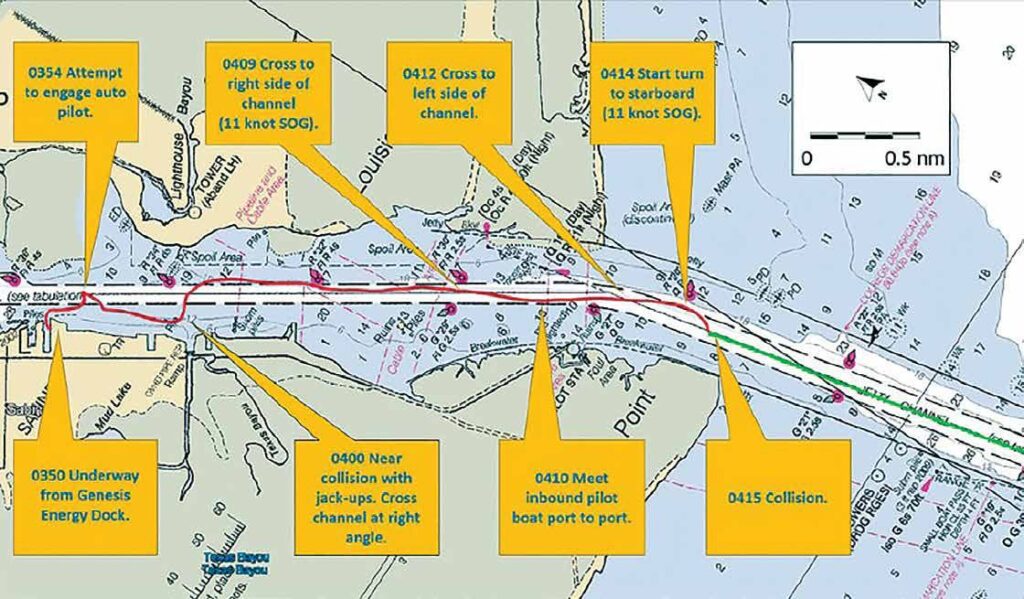
The Cheramie Bo Truc No 22’s no.1 port fuel tank was severely damaged. The no. 2 port fuel tank suffered less damage but was also compromised. An estimated 6,641 gallons of diesel fuel were released into the environment. As a result of the damage, the Cheramie Bo Truc No 22, valued at $1.2 million, was declared a total loss.
The Texas suffered hull damages amounting to $594,846. The Mariya Moran required repairs to the rams that secured it to the Texas amounting to $59,726. Neither vessel’s hull was compromised.
Additional Information
The Cheramie Bo Truc No 22 AB told investigators he saw both ATB sidelights, then only one, although he could not remember which color. The AB believed they would have passed safely starboard to starboard had the mate not turned to starboard in the path of the ATB. He also stated that in his 2 weeks on board, he never saw the autopilot used.
The Mariya Moran/Texas AB went below after escorting the pilot to the wheelhouse. It was not practice or procedure aboard the ATB for an AB to stand a lookout watch except during restricted visibility. Inside the sea buoy at each port, a tankerman stood by in case needed as a lookout or to drop the anchor. At the time of the accident, the tankerman was inside the office on the barge.
L&M Botruc Rental’s Alcohol, Firearms, and Controlled Substances Policy prohibited alcohol from being consumed or brought on company property. The Cheramie Bo Truc No 22 captain administered post-casualty alcohol tests to the mate, AB, and engineer after the collision, as required by company policy. He used saliva swab test kits, and the mate’s results indicated a blood alcohol concentration of at least 0.02 grams per deciliter (g/dL). The saliva test could only identify whether the amount present in saliva was above or below the threshold; it could not provide a numeric result for the actual blood alcohol content. Results for the other two crewmembers were negative.
Later investigation revealed that one of the test packages was expired, although it was not known which crewmember had used that specific test kit.
Analysis
Navigating in channels and harbors requires quicker reaction times due to traffic, currents encountered, and frequent course changes, and more rudder due to slower speeds. Marine autopilots such as the one installed on the Cheramie Bo Truc No 22 hold a vessel’s heading but not a course. Additionally, because marine autopilots have settings including gain (sensitivity before rudder actuates) and maximum rudder, they are not well-suited for the quicker reaction times and greater rudder often needed in channels and harbors. Therefore, autopilot use is often discouraged or prohibited in restricted waters.
The manual for the Cheramie Bo Truc No 22’s autopilot specifically warned users not to use autopilot in a “harbor entrance or narrow channel.” Despite this warning, the mate attempted to use the autopilot after getting under way on the accident voyage. As a result, he struggled to maintain a safe course during the first 12 minutes of the passage, nearly striking a stationary jack-up before returning to manual steering.
The Cheramie Bo Truc No 22 AB and engineer stated they had to correct the mate’s steering in the channel twice (before the turn in front of the ATB), but they did not summon the captain. They recognized the developing hazardous situation as the mate started the turn toward the ATB and again advised the mate to steer to port. The mate ignored their concern. They did not take further action despite the hazardous situation.
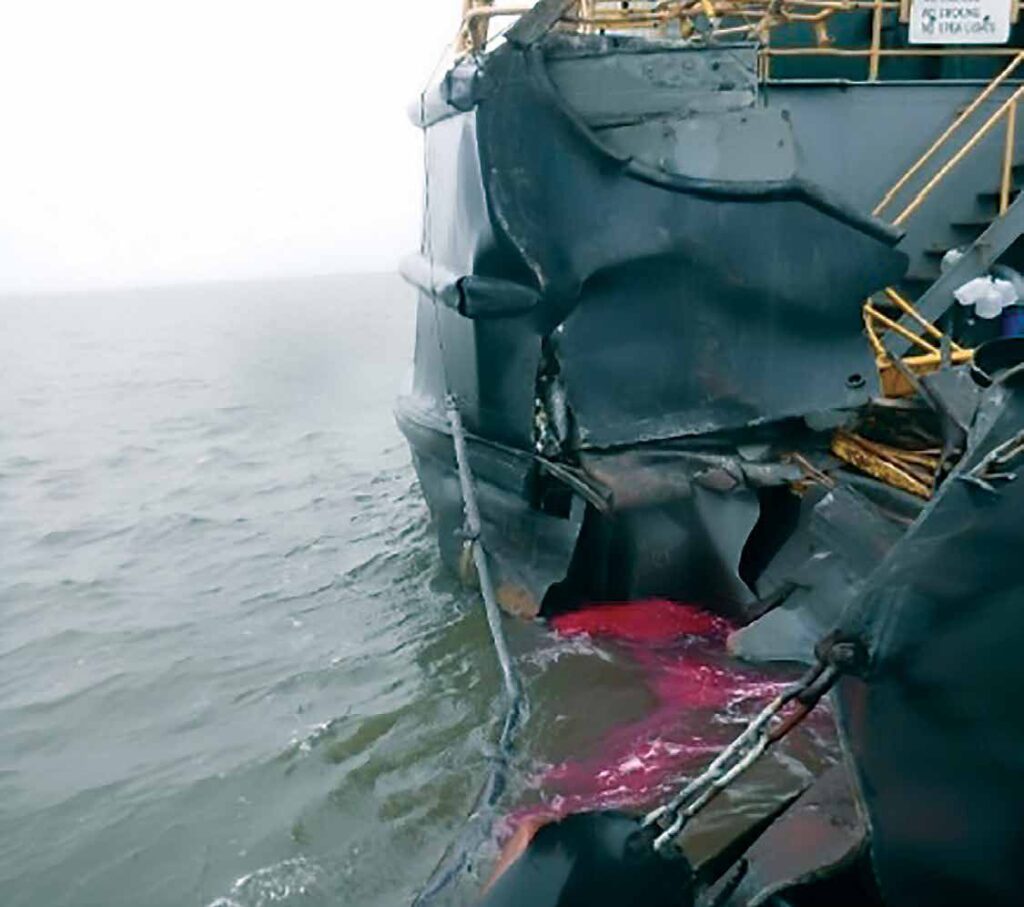
Following the return to manual steering, the Cheramie Bo Truc No 22 crossed the channel three times and wound up on the east side prior to meeting the Mariya Moran/Texas ATB. Although both vessels were aware of each other, no VHF radio passing arrangement or maneuvering signals were made.
VTS and AIS data and statements by the Cheramie Bo Truc No 22 AB and Mariya Moran/Texas pilot show that there was room to pass safely starboard to starboard had Cheramie Bo Truc No 22 continued parallel to and along the east edge of the channel after passing buoy 27. The Mariya Moran/Texas pilot assumed a starboard-tostarboard passing based on the position of the Cheramie Bo Truc No 22. Inland Navigation Rules require either a port-to-port passage or communication either by radio or whistle signal for an agreed-upon alternate passage between two vessels. A radio call from the ATB prior to the pilot relieving the mate to confirm the offshore supply vessel’s intentions may have kept the Cheramie Bo Truc No 22 mate from steering across the ATB’s bow. After the turn to starboard across the bow of the ATB, the collision was unavoidable.
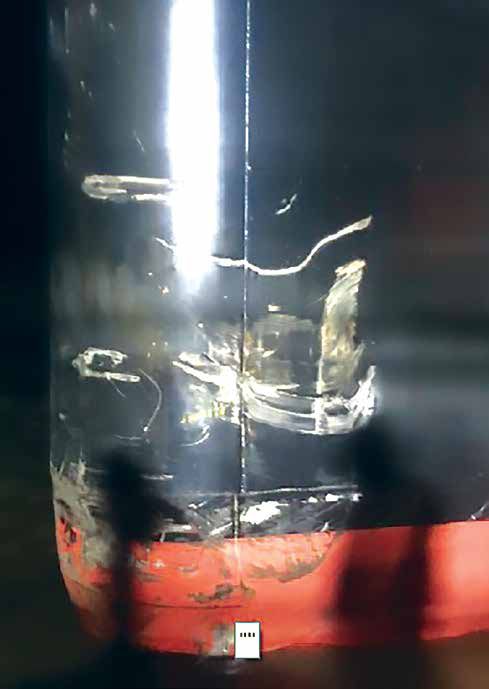
The alcohol swab test, although indicative that the mate consumed alcohol sometime prior to the voyage, does not demonstrate conclusively that the mate was impaired by alcohol. The regulatory limit for commercial mariners is 0.04 g/dL. However, attempting to use the autopilot in a channel, nearly colliding with stationary jack-ups, weaving across the channel, ignoring the warnings from the on-watch AB and engineer in the wheelhouse, and suddenly turning in front of the ATB all indicate a degree of misjudgment, impairment, and/or incompetence.
Probable Cause
The National Transportation Safety Board determines that the probable cause of the collision between the offshore supply vessel Cheramie Bo Truc No 22 and ATB Mariya Moran/Texas was the offshore supply vessel mate’s turn across the path of the ATB during a meeting situation. Contributing to the accident was a lack of early communication from both vessels.
Teamwork
Safe and effective navigation is not one person’s job. Bridge resource management includes the concept of teamwork, which is an essential defense against human error. A good team should anticipate dangerous situations and recognize the development of an error chain. If in doubt, team members should speak up or notify a higher authority. Vessel operators should train their crews on and enforce their safety policies.
Republished from Marine Construction Magazine Issue V, 2022






